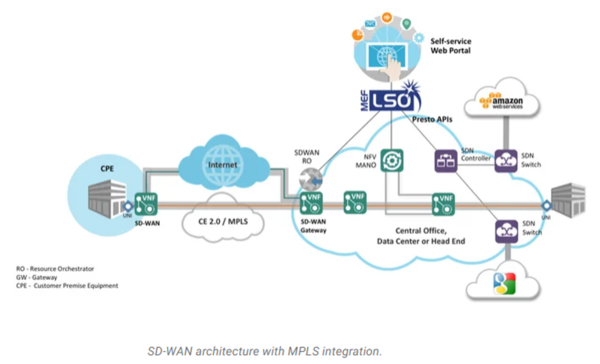Software-Defined WAN (SD-WAN)
A Software-Defined Wide Area Network (SD-WAN) is a virtual WAN architecture that allows enterprises to leverage any combination of transport services – including MPLS, LTE and broadband internet services – to securely connect users to applications. An SD-WAN uses a centralized control function to securely and intelligently direct traffic across the WAN. This increases application performance, resulting in enhanced user experience, increased business productivity and reduced costs for IT.[1]
SD-WAN Architecture[2]
SD-WAN uses an abstracted architecture for its network. In an abstracted architecture, the network is divided into two parts: the control plane and the forwarding plane. This architecture moves the control plane to a centralized location like an organization’s headquarters. That way, the network can be managed remotely without the need for an on-premises IT crew.
There are three main components to an SD-WAN: The SD-WAN edge, the controller, and the orchestrator.
- The SD-WAN edge is where the network endpoints reside. This can be a branch office, a remote data center, or cloud platform.
- An SD-WAN Orchestrator is the virtualized manager for network, overseeing traffic and applying policy and protocol set by operators.
- The SD-WAN Controller centralizes management, and enables operators to see the network through a single pane of glass, and set policy for the orchestrator to execute.
These components make up the basic structure of an SD-WAN. In addition, there are three main types of SD-WAN architecture: on-premises, cloud-enabled, and cloud-enabled with a backbone.
- An On-premises SD-WAN is where the SD-WAN hardware resides on-site. Network operators can directly access and manage the network and the hardware it resides on, and it does not use the cloud for its connections. This makes making it ideal for sensitive information that cannot be sent over the internet.
- Cloud-enabled SD-WANs connect to a virtual cloud gateway over the internet, which makes the network more accessible, and provides better integration and performance with cloud-native applications.
- Cloud-Enabled with Backbone SD-WANs give organizations an extra backup by connecting the network with a nearby point of presence (PoP), such as within a data center. It allows an SD-WAN to switch from public internet to a private connection, which adds an extra layer of security and consistency in case the connection is overwhelmed or fails.
How Does SD-WAN Work?[3]
There are several characteristics that are generally attributed to SD-WANs. Let’s walk through them and learn more about the way SD-WAN works.
- Centralized control: The primary means of control in an SD-WAN is centralized. It often resides in a SaaS application running on a public cloud. Control is decoupled from the hardware to simplify network management and improve the delivery of services. SD-WAN appliances (and virtual appliances) follow operational rules passed down from the central controller. This greatly reduces or eliminates the need to manage gateways and routers on an individual basis.
- Multi-connection, multi-transport: SD-WAN gateways support hybrid WAN, which implies that each gateway can have multiple connections using different transports—MPLS, broadband Internet, LTE, etc. A virtual private network (VPN) is typically set up across each WAN connection for security. Consequently, the SD-WAN can be an overlay spanning a diverse communications infrastructure.
- Dynamic path selection: Another feature of SD-WAN is dynamic path selection—the ability to automatically and selectively route traffic onto one WAN link or another depending on network conditions or traffic characteristics. Packets may be steered onto a particular link because another link is down or not working very well, or to balance network traffic across all available links. SD-WAN can also identify packets by application, user, source/destination, etc. and send them down one path or another based on those characteristics.
- Policy-based management: Policy is what determines where dynamic path selection will steer traffic and what level of priority (quality of service, or QoS) it is given. Business intentions can be implemented as policies via the central management console. New and updated policies are translated into operational rules and downloaded to all SD-WAN gateways and routers under control. A policy may be created, for example, to ensure the best performance for VoIP and interactive web conferences by giving their packets transmission priority and routing them onto low-latency paths. Cost savings can be realized by sending file back-ups across a broadband Internet connection. WAN traffic that requires a high level of security can be restricted to private connections (e.g., MPLS) between sites and required to pass through a robust security stack when entering the enterprise.
- Service chaining: An additional characteristic of SD-WAN is the ability chain it together with other network services. WAN optimization (acceleration) is often combined with SD-WAN to improve network and application performance. Internet traffic leaving and entering a branch office may be routed across a VPN to a cloud-base security service to strike a balance between performance, security, and cost.
- ↑ Definition - What Does Software-Defined WAN (SD-WAN) Mean? Silver Peak
- ↑ SD-WAN Architecture SDX Central
- ↑ How Does SD-WAN Work? Riverbed

